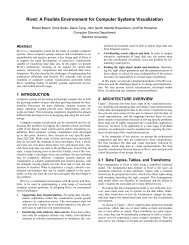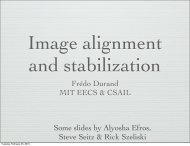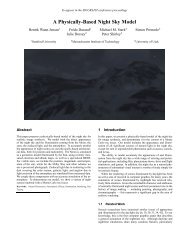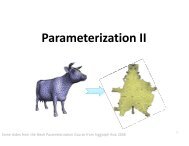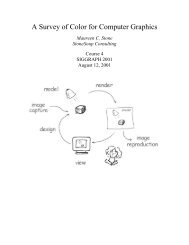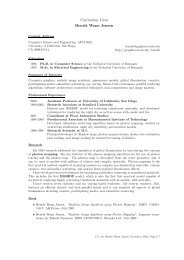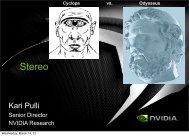Curved Folding - Computer Graphics Laboratory
Curved Folding - Computer Graphics Laboratory
Curved Folding - Computer Graphics Laboratory
You also want an ePaper? Increase the reach of your titles
YUMPU automatically turns print PDFs into web optimized ePapers that Google loves.
If a vertex p in the planar mesh P is shared by k faces, then p corresponds<br />
to k different vertices m 1 , . . . , m k of the corresponding<br />
k faces in M. Since these vertices should agree in the final mesh,<br />
we use a vertex agreement term of the form:<br />
Fvert := X (m i +<br />
m j<br />
+) 2 ,<br />
where the sum extends over all ` ´ k<br />
combinations per vertex p 2 P ,<br />
2<br />
and over all vertices in P .<br />
For M to approximate an underlying data surface D, we include a<br />
fitting term Ffit which is quadratic in the vertex coordinates m. Let<br />
mc denote the closest point in D to m, and let nc denote the unit<br />
normal at mc to the underlying surface. We use a linear combination<br />
of the squared distance (m mc) 2 and the squared distance to<br />
the tangent plane [(m mc) nc] 2 as the data fitting term. When<br />
fitting curves, especially near boundaries, we use tangent lines instead<br />
of tangent planes.<br />
Finally, we need a fairness term Ffair. For each pair of adjacent<br />
quads M i and M j of the PQ strip, we use the discrete bending energy<br />
of the corresponding developable surface wij(n i + n j<br />
+ )2 , as<br />
given by Equations (2) and (3), as the fairness term. The normal of<br />
a quad M i of M is given by n i = e i 1 e i 2. Under small displacements,<br />
this normal linearly varies as n i + = n i + c i<br />
n i . Given<br />
a polyline (p1, . . . pn) representing a fold line, i.e., a crease or a<br />
segment of a boundary curve, the contribution to Ffair is a sum of<br />
squared second differences P (pi 1 2pi+pi+1) 2 . Fairness terms<br />
are also applied to the respective polylines in the planar domain P .<br />
The fairness term Ffair alone is not always sufficient to maintain<br />
convex quads, and to prevent flips in the planar mesh P , especially<br />
when the quads become thin after several steps of subdivision.<br />
Hence we add another term Fconv to enforce convexity. We<br />
assume that the orientation of each face of P coincides with the<br />
orientation of the plane induced by the frame (o; e1, e2). A corner<br />
(pi 1, pi, pi+1) of a planar polygon is convex if and only if the<br />
oriented area of the triangle ∆(pi 1, pi, pi+1) is positive. This<br />
term also prevents flipping of faces.<br />
The algorithm. Combining all individual terms, our basic optimization<br />
problem reads,<br />
minimize F = Fvert + λFfit + µFfair<br />
subject to Fconv 0.<br />
We alternately minimize the objective function over new positions<br />
of vertices in P , and displacements of faces in space, i.e., velocity<br />
vectors for the corresponding face planes. Observe that the weights<br />
wij of Ffair, which only depend on the planar mesh P , remain fixed<br />
when optimizing for displacements of faces in space and the side<br />
condition Fconv is also not needed. Hence, the spatial sub-problem<br />
E1<br />
E1<br />
E1 E1 E1<br />
E2<br />
E2<br />
E2 E2 E2<br />
Figure 9: Basic setup for bending energy minimization. We start<br />
with a regular grid (left). After prescribing point locations and<br />
tangent planes at the boundary the basic optimization is applied.<br />
(Right) The result after one round of optimization.<br />
(5)<br />
Figure 10: Results of bending energy minimization for different<br />
boundary conditions. Given user constraints, the final models are<br />
obtained by alternately optimizing and subdividing.<br />
amounts to solving a sparse linear system, and subsequent application<br />
of the corresponding rigid body motion per face. Optimizing<br />
the development P is more involved since the weights wij change<br />
in a non linear way as the geometry of P changes. Additionally<br />
we have a quadratic term Fconv to maintain convexity as a side constraint.<br />
With the meshes scaled to fit inside a unit cube, we found<br />
λ = 1 and µ = 10 4 to be good values to start the optimization.<br />
Given an initial mesh P and a polygon soup M that roughly approximates<br />
a developable shape, we alternately optimize for P and<br />
M. The optimization terminates when the vertex agreement term<br />
falls below a given threshold. For the next refinement level, we subdivide<br />
the current mesh P , and map the new faces to space using<br />
the rigid transformation associated with the faces of P at the current<br />
level. The refinement process splits each quad of P to form<br />
two new ones. Splitting is performed along the edges that do not<br />
correspond to ruling directions (see Figure 3, right). The process is<br />
repeated until desired accuracy is reached.<br />
4 Applications to surface design<br />
In this section we employ the basic optimization algorithm to the<br />
design of objects with curved folds.<br />
Developable surfaces with minimal bending energy. As a<br />
simple application of our framework, without any relation to curved<br />
folding yet, we allow the user to take a planar strip of paper and attach<br />
it to some points and/or lines in space. The resulting shape is<br />
computed using a bending energy minimization, as popularly done<br />
for spline curves and double curved surfaces. Our approach extends<br />
the paper modeling tool of Bo and Wang [2007].<br />
Since ruling directions are unknown, we initialize optimization<br />
from a soup of congruent quadrilaterals as shown in Figure 9. The<br />
user can prescribe new locations for the boundary edges E1 and E2<br />
as well as the tangent planes at these edges, i.e., the planes of the<br />
outermost quads. We obtain the resulting shape by minimizing<br />
F = Fvert + µFfair. (6)<br />
Figure 10 shows several results obtained using our modeling tool.<br />
In all cases, the final maximal vertex disagreement is lower than<br />
10 4 (with the models scaled to fit a unit box).




